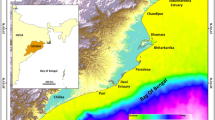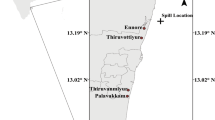Abstract
This paper discusses the prediction of oil spill movement using a trajectory model in case of a possible oil spill in the Bay of Bengal, off Odisha coast. Ten thousand barrels of medium crude oil assumed to have spilled into the sea at a location about 85 km away from the beach. A trajectory model was simulated to understand the movement of oil pollutants for a random date using GNOME, developed by National Oceanic and Atmospheric Administration. This study analyzed a few years of ocean current and wind data for better parameterization of the trajectory model and simulated several scenarios using varying wind speeds and directions. The result showed that wind speed and direction have a significant role in the oil spill movement. One of the scenarios suggests that within 29 h of the spill, oil pollutant will reach coast affecting a considerable area. The Devi estuary and Mahanadi estuary, which host extensive mangroves, various species of flora and fauna, will be affected by the above spill. This study, for the first time, has provided an understanding of oil spill forecasting and trajectory modeling for Odisha coast.


source: https://www.marinetraffic.com)










Similar content being viewed by others
References
Carpenter A (2019) Oil pollution in the North Sea: the impact of governance measures on oil pollution over several decades. Hydrobiologia 845:109–127. https://doi.org/10.1007/s10750-018-3559-2
Chang SE, Stone J, Demes K, Piscitelli M (2014) Consequences of oil spills: a review and framework for informing planning. Ecol Soc 19(2):26. https://doi.org/10.5751/ES-06406-190226
Chassignet EP, Hurlburt HE, Smedstad OM, Halliwell GR, Hogan PJ, Wallcraft AJ, Baraille R, Bleck R (2007) The HYCOM (HYbrid Coordinate Ocean Model) data assimilative system. J Mar Syst 65(1):60–83
Chen B, Ye X, Zhang B, Jing L, Lee K (2019) Marine oil spills—preparedness and countermeasures. In: Sheppard C (ed) World seas: an environmental evaluation (second edition) volume III: ecological issues and environmental impacts, 2nd edn. Academic Press, pp 407–426
Daling PS, Strom T (1999) Weathering of oils at sea: model/field data comparisons. Spill Sci Technol Bull 5(1):63–74
Desa E, Zingde MD, Vethamony P (2002) Marine Environmental Management Strategies for the Gulf of Kachchh. Report No. NIO/SP-13/2003 National Institute of Oceanography, Goa
Ghosh AK, Pattanaik AK (2005) Chilika lagoon: experience and lesions learned brief. Prepared for the GEF Lake Basin Management Initiative. https://www.Worldlakes.org
Gilbert TD (1999) Oil spills in the Australian marine environment: environmental consequences and response technologies. In: Proceedings of the Australian oil and gas conference, Perth, 22–23 Apr 1999
GNOME User Manual (2002) GNOME Publication, Hazardous Materials Response Division, National Oceanic and Atmospheric Administration Office of Response and Restoration (NOAAOR&R), United States
Gurumoorthi K, Venkatachapathy R, Mugilarasan M, Sharmila N (2016) Simulation of hypothetical oil spill trajectory model for southern tip of India. IJSIT 5(5):343–363
Han Y, Nambi IM, Clement TP (2018) Environmental impacts of the Chennai oil spill accident—a case study. Sci Total Environ 626:795–806. https://doi.org/10.1016/j.scitotenv.2018.01.128
Korsah P, Anifowose B (2014) Oil spill trajectory simulation for the Saltpond oilfield, Ghana, West Africa. Abu Dhabi Int Pet Exhib Conf. https://doi.org/10.2118/172124-MS
Kumar TS, Mahendra RS, Nayak S, Radhakrishnan K, Sahu KC (2010) Coastal vulnerability assessment for Orissa State, east coast of India. J Coastal Res 26(3):523–534
Lopez JR, March RR, Gonzalez SG, Socias FS (2006) Simulation of oil spills at the Casablanca platform (Tarragona, Spain) under different environmental conditions. J Mar Res 3(1):55–72
Mani Murali R, Kumar R (2009) Mapping of Environmental Sensitive Index (ESI) for the oil spills at Goa coast, India. In: Proceedings of geomatrix. IIT, Bombay
Marta-Almeida M, Ruiz-Villarreal M, Pereira J, Otero P, Cirano M, Zhang X, Hetlanda R (2013) Efficient tools for marine operational forecast and oil spill tracking. Mar Pollut Bull 71(1–2):139–151
Metzger EJ, Hurlburt HE, Wallcraft AJ, Shriver JF, Townsend TL, Smedstad OM, Thoppil PG, Franklin DS ( 2009) Validation test report for the global ocean prediction system V3.0—1/12° HYCOM/NCODA: Phase II. NRL Memo. Report, NRL/MR/7320-10-9236
Metzger EJ, Smedstad OM, Thoppil PG, Hurlburt HE, Cummings JA, Wallcraft AJ, Zamudio L (2014) US Navy operational global ocean and Arctic ice prediction systems. Oceanography 27(3):32–43. https://doi.org/10.5670/oceanog.2014.66
Mishra SP, Panigrahi PK, Das S, Parida T (2018) Endemism, ethno botany, and invasive allied species of Odisha—a bio-geo-diversity study. Int J Adv Res 6(9):401–423
Mohanty PK, Panda US, Mishra P (2008) Monitoring and management of environmental changes along the Orissa coast. J Coast Res 24(2B):13–27
Nanda PK (2011) The port of Paradip: mangrove forest to a major port. In: Orissa review. Government of Orissa, pp 68–78
Oil Tanker Spill Statistics (2019) The international tanker owners pollution federation. https://www.itopf.org/fileadmin/data/Documents/Company_Lit/Oil_Spill_Stats_brochure_2020_for_web.pdf
Panda SP, Subudhi H, Patra HK (2013) Mangrove forests of river estuaries of Odisha, India. Int J Biodivers Conserv 5(8):446–454. https://doi.org/10.5897/IJBC12.004
Panda M, Murthy TVR, Samal RN, Lele N, Pattnaik AK, Chand PK (2017) Diversity of true and mangrove associates of Bhitarkanika National Park, Odisha, India. Int J Adv Res 5(1):1784–1789
Rajapriyadharshini JR, Sudaliamani K (2017) Oil spill trajectory forecast with the aid of gnome. Res J Mar Sci 5(3):1–6
Remyalekshmi R, Hegdge AV (2013) Numerical modelling of oil spill movement along North–West coast of India using GNOME. Int J Ocean Clim Syst 4(1):75–86
Roychoudhury N, Meshram PB, Mishra RK (2017) Floral diversity in mangrove forests of Bhitarkanika, Odisha. VanSangyan 4(10):1–10
Prasad SJ, Balakrishnan Nair TM, Francis PA, Vijayalaksmi T (2014) Hindcasting and validation of Mumbai oil spills using GNOME. Int Res J Environ Sci 3(12):18–27
Samuels WB, Amstutz DE, Bahadur R, Ziemniak C (2013) Development of a global oil spill modeling system. Earth Sci Res 2(2):52–61
Saravanan KR, Sivakumar K, Choudhury BC (2013) Important coastal and marine biodiversity areas of India. In: Sivakumar K (ed) Coastal and marine protected areas in india: challenges and way forward, ENVIS bulletin: wildlife and protected areas, vol 15. Wildlife Institute of India, Dehradun, pp 134–188
Sebastião P, Guedes SC (1995) Modelling the fate of oil spills at sea. Spill Sci Technol Bull 2:121–131
Simecek-Beatty D, Lehr WJ (2007). Trajectory modeling of marine oil spills. In: Wang Z, Stout SA (eds) Oil spill environmental forensics, chapt 3. Academic Press, Burlington, MA, pp 405–418
Toz AC, Koseoglu B (2018) Trajectory prediction of oil spill with Pisces 2 around Bay of Izmir, Turkey. Mar Pollut Bull 126:215–227. https://doi.org/10.1016/j.marpolbul.2017.08.062
Vethamony P, Sudheesh K, Babu MT, Saran AK, Mani Murali R, Rajan B, Srivastava M (2007) Trajectory of an oil spill off Goa, eastern Arabian Sea: field observation and simulation. Environ Pollut 148(2):438–444
Wessel P, Smith WHF (1996) A global, self-consistent, hierarchical, high-resolution shoreline database. J Geophys Res 101(B4):8741–8743. https://doi.org/10.1029/96JB00104
Zabbey N, Olsson G (2017) Conflicts—oil exploration and water. Glob Chall (Hoboken, NJ) 1(5):1600015. https://doi.org/10.1002/gch2.201600015
Zafirakou A (2018). Oil spill dispersion forecasting models, monitoring of marine pollution, Houma Bachari Fouzia, IntechOpen, https://doi.org/10.5772/intechopen.81764. https://www.intechopen.com/books/monitoring-of-marine-pollution/oil-spill-dispersion-forecasting-models
Zelenke B, O'Connor C, Barker C, Beegle-Krause CJ, Eclipse L (eds) (2012) General NOAA Operational Modeling Environment (GNOME) Technical Documentation. US Dept. of Commerce, NOAA Technical Memorandum NOS OR&R 40. Emergency Response Division, NOAA, Seattle. https://response.restoration.noaa.gov/gnome_manual
Author information
Authors and Affiliations
Corresponding author
Additional information
Publisher's Note
Springer Nature remains neutral with regard to jurisdictional claims in published maps and institutional affiliations.
Rights and permissions
About this article
Cite this article
Pradhan, B., Das, M. & Pradhan, C. Forecasting oil spill movement through trajectory modeling: a case study from Bay of Bengal, India. Model. Earth Syst. Environ. 7, 1107–1119 (2021). https://doi.org/10.1007/s40808-020-00933-4
Received:
Accepted:
Published:
Issue Date:
DOI: https://doi.org/10.1007/s40808-020-00933-4




